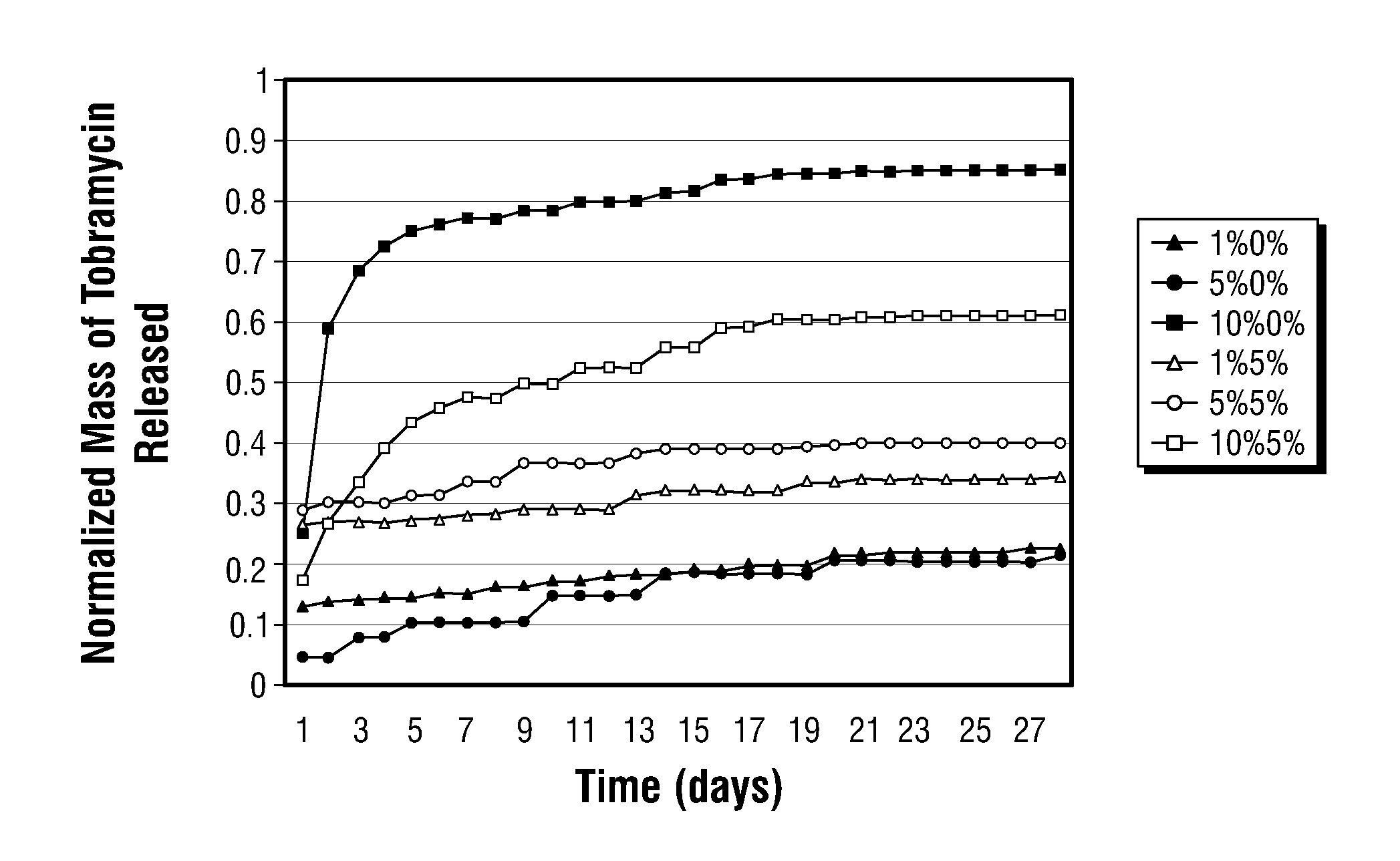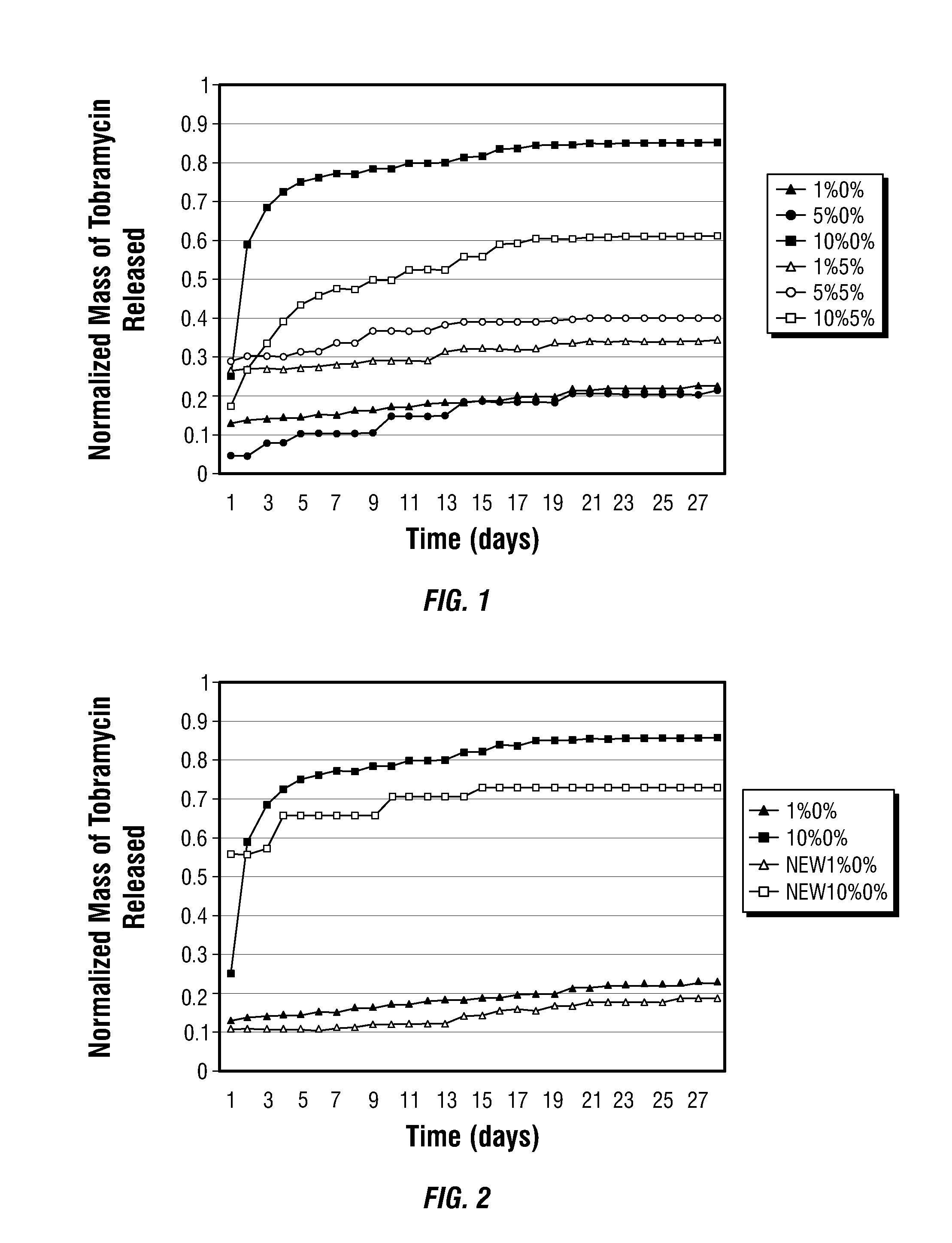Antibiotic microspheres for treatment and prevention of osteomyelitis and enhancement of bone regrowth
a technology of osteomyelitis and antibiotic microspheres, applied in the field of microspheres, can solve the problems of nonlinear elution of antibiotics, high serum concentrations of antibiotics, and gastroinstestinal side effects
- Summary
- Abstract
- Description
- Claims
- Application Information
AI Technical Summary
Benefits of technology
Problems solved by technology
Method used
Image
Examples
example 1
PLGA / Tobramycin Drug Delivery System
[0028]Preparation of Microspheres
[0029]In the following examples the polylactic-co-glycolic acid (PLGA) used was a high molecular weight blend of 50% lactic to 50% glycolic acid (Medisorb®), from Alkermes, Cincinnati, Ohio. Polyethylene glycol (PEG) and polyvinyl alcohol (PVA) were purchased from Sigma Aldrich, of St. Louis, Mo. Tobramycin (Nebcin®), from Eli Lilly, Indianapolis, Ind. was purchased in powder form, and all remaining chemicals were purchased from Fisher Scientific (Pittsburgh, Pa.).
[0030]Microparticles were prepared in many blends of PLGA / PEG / tobramycin using an established water-in-oil-in-water (W / O / W), double-emulsion-solvent-extraction technique. The size distribution of the microparticles was measured with a Coulter counter multisizer (model 0646, Coulter Electronics, Hialeah, Fla.) after suspending the particles in an Isoton II solution (Coutler Electronics).
[0031]The entrapment efficiency of the formulation was determined in d...
example 2
PLGA / Tobramycin / PMMA
Parenteral Antibiotics
[0052]To test the effectiveness in eradicating an established case of osteomyelitis, a study was conducted using a rabbit model of osteomyelitis, wherein the two methods of local antibiotic therapy were tested, i.e., the microspheres and polymethyl methacrylate (PMMA) bone cement against parenteral antibiotics.
[0053]Materials and Methods
[0054]Forty New Zealand White adult male rabbits, weighing 3-4 kg were selected for this study. Each rabbit underwent an initial surgery to inoculate the radius with bacteria in a well-established procedure. Four weeks later, each rabbit was returned to the operating room for irrigation and debridement surgery and a wound culture. At the time of the second surgery, each animal was randomly placed into one of 5 groups for treatment of the infection:
[0055](1). Control: control group treated with PLGA microspheres containing no antibiotic,
[0056](2). Microspheres: PLGA microspheres with 10% tobramycin,
[0057](3). ...
example 3
PLGA / Vancomycin / PMMA Microspheres
[0092]Studies were also performed that are similar to the examples and formulations described above, with vancomycin substituted for tobramycin. In these experiments, microspheres of about 6.86 μm (microns) in diameter containing approximately 5% by weight vancomycin, and microspheres of about 7.46 μm (microns) in diameter containing approximately 10% by weight vancomycin, and 90% by weight 50:50 PLGA were produced. The percentage of PEG in the formulations was either 0% or 5%.
[0093]The results of the entrapment efficiencies and elution rates of vancomycin over a period of 600 hours are presented in FIG. 7. The result was that over a 600 hour period, in the 10% vancomycin formulation approximately 27% of the vancomycin was eluted, and in the 5% vancomycin formulation approximately 40% of the vancomycin was eluted. The entrapment efficiency of the 10% vancomycin formulation was found to be approximately 20.4% for the 10% vancomycin formulation and an ...
PUM
| Property | Measurement | Unit |
|---|---|---|
| diameter | aaaaa | aaaaa |
| diameter | aaaaa | aaaaa |
| diameter | aaaaa | aaaaa |
Abstract
Description
Claims
Application Information
 Login to View More
Login to View More - R&D
- Intellectual Property
- Life Sciences
- Materials
- Tech Scout
- Unparalleled Data Quality
- Higher Quality Content
- 60% Fewer Hallucinations
Browse by: Latest US Patents, China's latest patents, Technical Efficacy Thesaurus, Application Domain, Technology Topic, Popular Technical Reports.
© 2025 PatSnap. All rights reserved.Legal|Privacy policy|Modern Slavery Act Transparency Statement|Sitemap|About US| Contact US: help@patsnap.com



